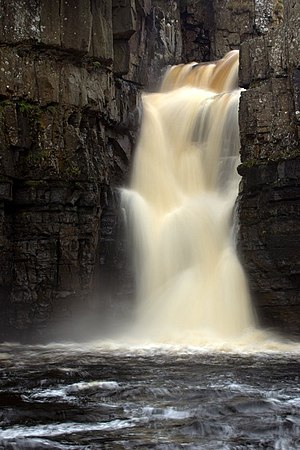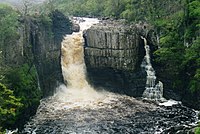High Force: Difference between revisions
Created page with '{{Infobox waterfall |name=High Force |county 1=County Durham |county 2=Yorkshire |river=River Tees |picture=High force.jpg |picture caption=High Force |os grid ref=NY880283 |type…' |
mNo edit summary |
||
| Line 12: | Line 12: | ||
}} | }} | ||
[[File:High Force from the Pennine Way - geograph.org.uk - 1726862.jpg|right|thumb|200px|A view including the second fall, R]] | [[File:High Force from the Pennine Way - geograph.org.uk - 1726862.jpg|right|thumb|200px|A view including the second fall, R]] | ||
'''High Force''' is a waterfall on the [[River Tees]], near [[Middleton-in-Teesdale]]. The river here, and therefore the waterfall, is the border | '''High Force''' is a waterfall on the [[River Tees]], near [[Middleton-in-Teesdale]]. The river here, and therefore the waterfall, is the border between [[County Durham]] and [[Yorkshire]]. | ||
High Force is one of the greatest waterfalls in Britain; it is not the highest for several others in the | High Force is one of the greatest waterfalls in Britain; it is not the highest, for several others in the [[Highlands]] and even elsewhere in Yorkshire manage to beat it, but its breadth and volume of water are impressive. | ||
The whole of the [[River Tees]] plunges over a precipice | The whole of the [[River Tees]] plunges over a rock precipice in two stages. In former times flooding created two separate falls, but after the completion of Cow Green Reservoir in the upper Teesdale this seldom happens now. In harsh winters the falls would freeze, creating cathedral-like ice formations. | ||
High Force is where the River Tees crosses the Whin Sill – a hard layer of igneous rock (also seen at [[Hadrian's Wall]] and other locations). The waterfall itself consists of three different types of rock. The upper band is made up of whinstone, or dolerite, a hard igneous rock which the waterfall takes a lot of time to erode. The lower section is made up of Carboniferous Limestone, a softer rock which is more easily worn away by the waterfall. Between these two layers is a thinner layer of Carboniferous sandstone, which was baked hard when the Whin Sill was molten 295 million years ago. The wearing away of rock means that the waterfall is slowly moving upstream, leaving a narrow, deep gorge in front of it. The length of the gorge is currently about 700 yards. The bedload (rocks that the river is carrying) is mainly composed of large boulders, which are rolled along the river bed. Upstream of the waterfall, the river is narrow; downstream, it widens and meanders. | High Force is where the River Tees crosses the Whin Sill – a hard layer of igneous rock (also seen at [[Hadrian's Wall]] and other locations). The waterfall itself consists of three different types of rock. The upper band is made up of whinstone, or dolerite, a hard igneous rock which the waterfall takes a lot of time to erode. The lower section is made up of Carboniferous Limestone, a softer rock which is more easily worn away by the waterfall. Between these two layers is a thinner layer of Carboniferous sandstone, which was baked hard when the Whin Sill was molten 295 million years ago. The wearing away of rock means that the waterfall is slowly moving upstream, leaving a narrow, deep gorge in front of it. The length of the gorge is currently about 700 yards. The bedload (rocks that the river is carrying) is mainly composed of large boulders, which are rolled along the river bed. Upstream of the waterfall, the river is narrow; downstream, it widens and meanders. | ||
Latest revision as of 00:08, 27 March 2013
| High Force | |
| County Durham, Yorkshire | |
|---|---|
 High Force | |
| River: | River Tees |
| Fall: | 95 feet |
| Type: | single drop |
| NY880283 | |

High Force is a waterfall on the River Tees, near Middleton-in-Teesdale. The river here, and therefore the waterfall, is the border between County Durham and Yorkshire.
High Force is one of the greatest waterfalls in Britain; it is not the highest, for several others in the Highlands and even elsewhere in Yorkshire manage to beat it, but its breadth and volume of water are impressive.
The whole of the River Tees plunges over a rock precipice in two stages. In former times flooding created two separate falls, but after the completion of Cow Green Reservoir in the upper Teesdale this seldom happens now. In harsh winters the falls would freeze, creating cathedral-like ice formations.
High Force is where the River Tees crosses the Whin Sill – a hard layer of igneous rock (also seen at Hadrian's Wall and other locations). The waterfall itself consists of three different types of rock. The upper band is made up of whinstone, or dolerite, a hard igneous rock which the waterfall takes a lot of time to erode. The lower section is made up of Carboniferous Limestone, a softer rock which is more easily worn away by the waterfall. Between these two layers is a thinner layer of Carboniferous sandstone, which was baked hard when the Whin Sill was molten 295 million years ago. The wearing away of rock means that the waterfall is slowly moving upstream, leaving a narrow, deep gorge in front of it. The length of the gorge is currently about 700 yards. The bedload (rocks that the river is carrying) is mainly composed of large boulders, which are rolled along the river bed. Upstream of the waterfall, the river is narrow; downstream, it widens and meanders.
Access to the northern bank is by a private footpath for which a fee is charged. The southern bank can be reached free-of-charge on a public footpath.
Notable visitors
J M W Turner, the painter, arrived at High Force at 10:00 a.m. on 3 August 1816 to sketch the scene. He then travelled upstream to Cauldron Snout and eventually made his way to Dufton, across the fells, in inclement weather.
Arthur Young, the writer, came with his wife on horseback from Durham in 1771 and wrote:
The whole river (no trifling one) divided by one rock into two vast torrents pours down a perpendicular precipice of near fourscore feet: The deluging force of the water throws up such a foam and misty rain, that the sun never shines without a large and brilliant rainbow appearing... After preaching at Cuthberton and in Teesdale, I went a little out of my way, to see one of the wonders of nature. The river Tees rushes down between two rocks, and falls sixty feet perpendicular into a basin of water sixty feet deep ...